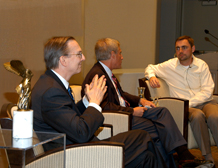

Top Scientists Explore the Origin of Life in Lasker Lecture
By Eric Sauter
A full house of faculty, staff, graduate students, and postdoctoral fellows filled Scripps Florida's Rodney B. Fink Education Pavilion on March 16, 2010, to hear Nobel laureate and Lasker Award winner Jack Szostak and Scripps Research Assistant Professor Brian Paegel speak. They addressed recent laboratory experiments that seek to recreate the formation of the first living cells from the basic chemical building blocks of nature.
"If it proves to be easy to build simple cells in the laboratory," Szostak said, "it might show that life could have formed quickly on earth and perhaps even other planets in similar ways."
Szostak's research at Harvard Medical School has focused on the use of fatty acids – the result of the breakdown of fats – to produce synthetic membranes or vesicles. Fatty acids, which are simple in their chemical structure, may have been part of the chemical soup found on early earth that gave rise to the first simple cellular life.
Szostak's research also addresses the rise of the first genetic system. "We are looking at the replication of primitive genetic materials, which is something of a challenge," Szostak said. "But if we can solve the problem of chemical replication of some genetic material, then we may be close to building simple living cells. Ultimately, we hope this will lead to a more complete explanation of how life itself began on the Earth."
Evolution in Real Time
Speaking after Szostak, Paegel joked that it was great having a Nobel Prize winner as an opening act, then set about describing his own work developing microchip technology for driving evolutionary processes in the laboratory.
Working with Scripps Research Professor Gerald Joyce of the La Jolla, California campus, Paegel developed microfluidic processors for observing molecular evolution in real time. He also discussed a new circuit that generates millions of identical microscopic water droplets in oil. Chemistry conducted in these droplets simulated the compartmentalized evolution that is observed in cells.
"We are treating emulsions and vesicles – very complex systems composed of countless molecular components – like simple molecules that can be made by a series of chemical steps," he said. "We need to have complete control over droplet size and the loading of molecular cargo into these microscopic compartments. Microfluidic technology allows us to custom-tailor all of these characteristics by forming one droplet at a time."
Paegel's chemistry and engineering has a practical side. "These devices will serve as a starting point for constructing more sophisticated compartments, such phospholipid bilayer vesicles, the membrane material used in cells. We expect that there could be applications in drug delivery and aiding studies of proteins that must be housed in a membrane to be properly functional."
The Lasker Lecture is part of a series of forums presented by the Lasker Foundation designed to support and promote a public dialogue over critical issues involving the biological sciences. The inaugural Lasker Lecture, "Reading the Human Genome: Genes and Brains," by biologist and two-time Lasker laureate Sydney Brenner, took place at the Fred Hutchinson Cancer Research Center in Seattle in November 2009. Scripps Research is the second host institution of the program.
Questions from the Audience
For the evening portion of the program at Scripps Florida, the lectern was replaced by an intimate drawing room atmosphere, with comfortable chairs, floor lamps, and Bob Bazell, chief science and health correspondent for NBC News, sitting between the two scientists, taking questions from the audience and asking several of his own.
Before getting to those questions, Bazell complimented Scripps Research on having found two "beautiful research locations in the sun" for scientists to work. They're probably much more productive because of it, he said – drawing laughter from the Scripps Florida faculty in the audience.
Many of the questions came from the dozen or so Palm Beach County high school students and teachers who showed up for the evening with questions in hand.
When asked what it takes to become a successful scientist, Szostak and Paegel replied with similar answers – persistence, passion, and curiosity. Both, however, added their own caveats.
"Be sure that persistence doesn't turn into stubbornness," Szostak said, recalling a time when he spent a year on a laboratory problem that in the end wasn't worth the effort. Paegel cautioned against accepting conventional wisdom. "In biology there are certain dogmas," he said, "but you shouldn't let them get in the way of thinking for yourself."
The best kind of student, Szostak noted, won't take "no" for answer: "They come to you with a new idea for an experiment and you tell them that it won't work. Then they go off and make it work and prove you wrong. That's who you want in your laboratory."
On the topic of Darwinian evolution – the subject of the day – one of the teachers asked Paegel how to convey the main message of evolution to his students and what precisely that main message ought to be.
"Evolution is the unifying theory of biology," Paegel told the audience. "Without evolution, biology makes no sense."
Send comments to: mikaono[at]scripps.edu

Bob Bazell (center), chief science and health correspondent for NBC News, chats with Harvard Medical School's Jack Szostak (left) and Scripps Florida's Brian Paegel as part of the Lasker Lecture program. (Photo by Davidoff Studios.)
